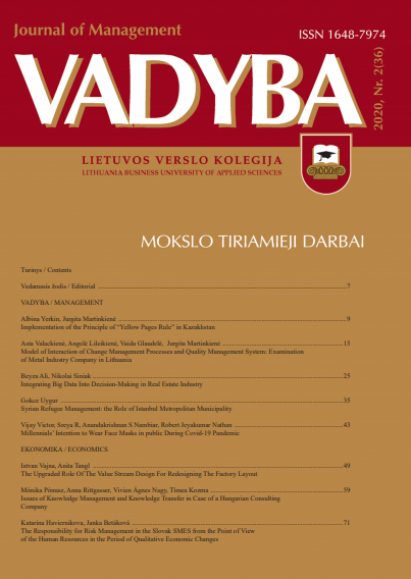THE UPGRADED ROLE OF THE VALUE STREAM DESIGN FOR
REDESIGNING THE FACTORY LAYOUT
THE UPGRADED ROLE OF THE VALUE STREAM DESIGN FOR
REDESIGNING THE FACTORY LAYOUT
Author(s): István Vajna, Anita TanglSubject(s): Economy
Published by: Lietuvos verslo kolegija
Keywords: factory layout; distance optimization; push; pull; lean; industry 4.0; Value Stream Design;
Summary/Abstract: The case study shows the re-optimization of an initial new factory layout design with Value Stream Design (VSD). The VSD is a quantitative method and its’ final goal is to make a waste free optimized material flow. The primary goal of arrangement is to reduce transportation distances and frequencies, optimize human load. Initially the whole factory shop floor layout design was already made in push concept. The plans were made by production management, logistics, engineering department at the headquarter of the multinational automotive company with based on VDI2870holistic concept linking strategy on tactics and operation. On the layout (v1.) the hundreds of machines were placed and arranged by CAD (Computer Design) engineers to fit the space. The factory building has 15,000 m2 with empty shop floor waiting for the final decisions for equipment. The factory production area was shared into six main production areas (P1-P6), which correlates with their product complexity of the product families.Each production area output can be finished product (FP) or semi-finished product (SFP) for the next production areas. To validate the whole factory layout it was necessary to involve lean experts that identified disadvantages and constraints. Without lean implementation the company’s transportation waste would be 49% more per year. The Value Stream Design importance nowadays is upgrading to a higher level, when the whole global business is changed, the labor force fluctuates, and the cost and delivery time reduction plays a vital role in the company’s profit and future.The research shows that if the decision taking is based on real data and facts the controlling and management can do its best in time. Using VSD andre-evaluating the transportation routes, frequency and costs is the first step to define a smooth, low cost, material flow (v2.). This development ensured the company to drive from push to pull production through mixed production system. Originally, the production flow was clockwise orientation. It was changed step by step to mixed production by eliminating work in process storages, implementing FIFO lanes, Milk Run, and Kanban. The total annual transportation distances were reduced from 4,905,000 m between the rump-up and serial production period. The warehouse storage size was reduced to 50% and implementation cost from €75,000 to €32,500. By eliminating work in process storages along production lines it was possible to open a new two way transportation road that also will serve the AGV’s operations in industry 4.0 projects. Due to decreased lead time the logistic labor productivity increased by 45%. Besides taking measurements for the VSD it was used Value Stream Mapping as a lean tool and an own designed VSD evaluation and a simulation software. The VSD team’s cooperative actions reduced the evaluation and validation time with 65%then it was initially planned. The implementations were evaluated from the rump-up phase to the first serial productions and the results were confirmed by controlling and management.
Journal: VADYBA
- Issue Year: 36/2020
- Issue No: 2
- Page Range: 49-57
- Page Count: 9
- Language: English

